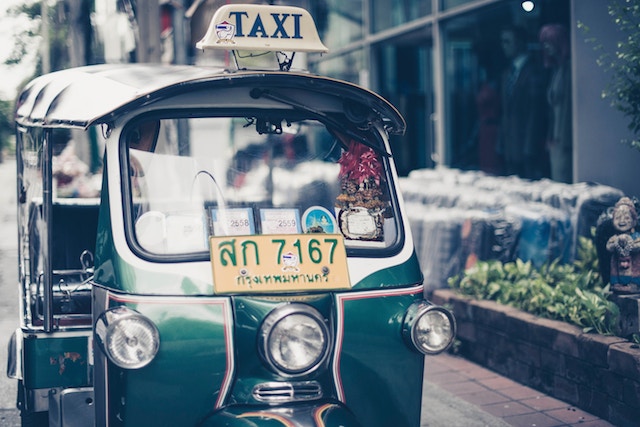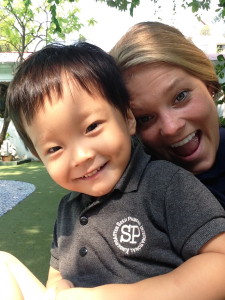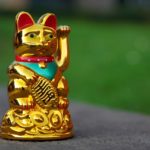What its Like to Teach at a Japanese School in Thailand

Ryou stared into my blue eyes with his big brown eyes and petted my blonde hair curiously. He touched my earrings, counting softly in Japanese. Ichi ni san. Cocking his head while doing this, he spoke seriously in his language. I smiled as the words entered my ears sounding like “blah blah blah.”
For the last five months, I have been teaching English to squeaky, polite, nose-picking, adorable Japanese kindergartners at an international school in Thailand. Yes, you read that correctly: I teach Japanese children in Thailand. My days are a mesh of konnichiwa, sawadee ka, unchi and “Good morning, Teacher Kirsten.”
Getting the job was the easy part. My interview consisted of a 15-minute demo lesson plus some awkward questions about why I came to Thailand and how I like the weather. (In case you were wondering, I love the weather!)
What its Like to Teach at a Japanese School in Thailand.
My school is an international school, which puts it at the top of the food chain for schools in Thailand; these schools are said to have the best standards for education, best teachers, and most resources available. My particular school caters to Japanese expats–parents who have been transferred to Thailand but still want their kids to get the same education they would get in Japan.
Their teachers teach them in Japanese; they follow the Japanese school year, celebrate Japanese holidays, and try to keep it as similar as possible, so when they return to Japan they fit right in. I go into their classrooms daily and teach English classes to 2-6 year olds.
Here are four things that I have learned while teaching at an international school in Thailand:
What its Like to Teach at a Japanese School in Thailand
1. There are endless celebrations.
We follow the Japanese calendar, but we also observe Thai holidays, and when Western holidays roll around, we get to celebrate those too. It is rare to go one week without there being something to celebrate. So celebrate we will! Learning about Japanese and Thai culture and their customs has been one of those most fascinating things about this job.
Just last week, for example, we celebrated Songkran, the Thai New Year. Songkran is about cleansing the soul and refreshing for the next year. Traditionally, it is celebrated with family events and religious worship; young children put water infused with flowers on to their elders and Buddha images and ask for blessings. Though it is still this way in some parts, in Bangkok it has turned into a giant water fight. At school, we celebrated with a water slide, squirt guns and buckets and buckets of cold water thrown at each other.
2. The Japanese teachers show no mercy.
If a child cries because of something they did, the teachers laugh. In one such occurrence, during the Japanese holiday known as Setsubun, the Japanese teachers dressed up as demons and came out and scared all the kids to tears. They all thought it was hilarious, and it is something repeated year after year. Traditionally, the demons represent the evil spirits that must be pushed out of the home by throwing rocks, nuts or pebbles.
Setsuban is customarily celebrated before the beginning of spring in Japan. To rid evil spirits from the home and all the evil of the former year, the head of the household would throw beans, rocks or nuts out the door and the family would chant “bad spirits out, good luck in.”
3. The Japanese teachers push the students to their limits.
During a field trip to a rice patty, we crossed a fish-filled river while balancing above. These five-year-olds were tight-roping across the river with one rope for their feet and one to hold onto with their hands. Many tears were shed, but there was no choice–they had to cross. Fortunately, they all made it safely. I have noticed that the children are not pitied or given as many choices, thus building their strong, brave, independent character.
4. The kindergarten graduation ceremony was more serious than my college graduation.
This event was unlike anything I have seen before. It consisted of daily practice for weeks: gowns, professional pictures, memorization of songs, chants and endless do-over’s as a child forgot to bow or stepped forward with the right foot instead of the left foot all under the sweltering Thai sun.
These six-year-olds had to march in unison to the stage, wait for their classmate to walk across the stage, walk up the staircase, wait again, accept their diploma bow, bow and bow again, do another turn and walk back to their seat. When it finally ended, you could see the relief wash over the kids like a waterfall.

Each day I learn something new about Asian culture, and each day brings a surprise that keeps me looking forward to the months ahead.
Join Pink Pangea’s Writing, Hiking and Yoga retreats! Photos by Unsplash and Kirsten I.








